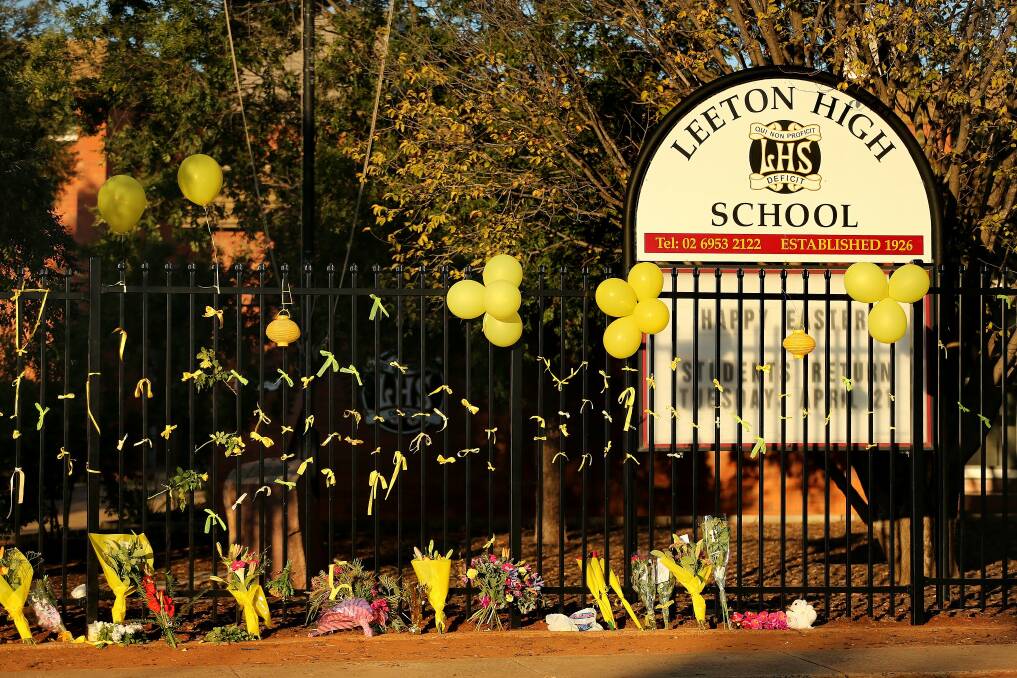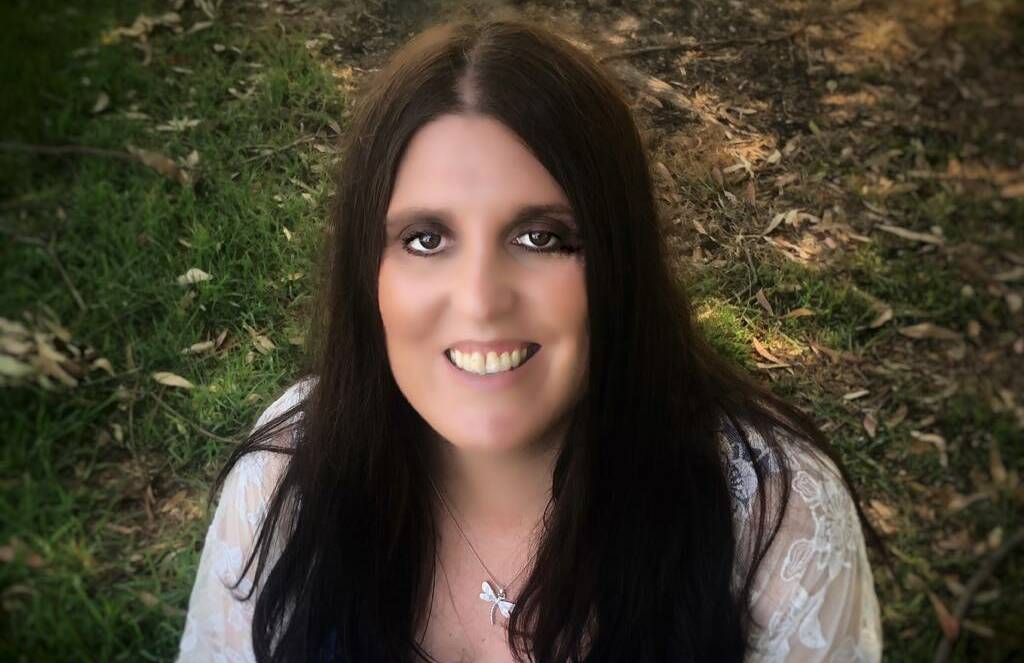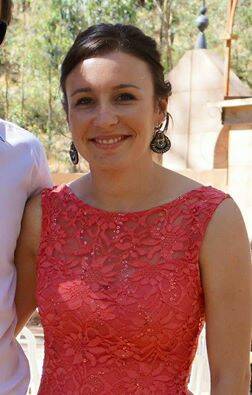
The murder of Stephanie Scott in Leeton shook the small town and much of the nation almost five years ago.
Subscribe now for unlimited access.
or signup to continue reading
The crime stayed in the minds of many for a number of reasons, but for Monique Patterson, it was the strength of a family and community in grieving that drove Miss Scott's memory.
Miss Patterson was the editor of Leeton's newspaper, The Irrigator, at the time of Miss Scott's murder and reported on the incident extensively.
"I've covered missing person cases before over my career, but this one struck me more than any other case had when it first came about," she said.
The thought of Miss Scott never left the journalist's mind, and in a bid to pay tribute to her memory, Miss Patterson started telling the young woman's story through pen on paper.
The result is a 214-page true crime book released by Miss Patterson, who continues her work as a journalist for ACM, titled United in Grief.
"I always thought about Stephanie, I always thought about what an amazing person she was based on what everyone said about her, that she was such a kind, generous person," Miss Patterson said.
"I know her family was very passionate about keeping her memory alive, and as a journalist, nothing has stayed in my mind like this so I wanted to help them do that."
Motivation to write
Stephanie Scott was kidnapped, beaten, raped and stabbed to death by a cleaner, Vincent Stanford, who worked at the town's high school where Miss Scott taught. Stanford later burned her body to hide the evidence.

Miss Scott was just 26 years old and due to marry her high school sweetheart, Aaron Leeson-Woolley, six days after she went missing.
"The number one reason I wrote this book, outside of Stephanie's glowing personality, was the way the community came together to do all they possibly could to help find her when she went missing," Miss Patterson said.
"The second reason was the incredible strength of the Scott family who, in their darkest hours, helped the community grieve as well as themselves, and bring comfort to everyone who knew Stephanie.
"No one could have ever imagined that Stephanie's body would be found the night before she was meant to be married, yet the Scott family did not shut themselves off from everyone, they grieved together."
The first Miss Patterson heard of Stephanie Scott was in Griffith where she was the editor for The Area News.
A journalist from Leeton - a paper in the same group - said a friend of Miss Scott's had come in and wanted a story to be done on her missing friend.
"As a journalist, you always think it's likely that a missing person will be found in a day or two after doing a story, but right from the start of this case, her friends and family were adamant Stephanie was not the type of person to run off without telling someone, and I knew this would be different," Miss Patterson said.

Critics
Despite good intentions, not everyone felt that writing a book on the murder was appropriate.
Miss Patterson said she had reached out to Kim, the sister of Miss Scott, ahead of writing United in Grief, but never heard back.
"I have had some negativity from people in Leeton who didn't want the book to be written, they had made comments on social media about it to which I reached out and offered them my contact details to get in touch, I am happy to listen to their feedback and concerns," she said.
"It was a difficult process to write this book because people don't think these types of cases affect journalists, and I don't say that to take away from everyone else, but to recount some of the details was difficult.
"I don't want to bring anymore pain to anyone, but I want to keep her memory alive."
Means of moving on
Known as 'the cop from Wagga', Terry O'Connell spent 30 years with the NSW Police Force before pioneering the concept of restorative justice in Australia.
The recently retired Australian Director of Real Justice said humanising traumatic incidents beyond a sentence for the perpetrator was an essential part of the healing process for a victim and their family.
"My experience suggests that regardless of what tragedy has happened, the community, family and friends affected are more likely to be helped when they are able to actually talk about the reality of the experience, and there is a strong argument to say that as painful as it is, a book such as [United in Grief] could be valuable in facilitating those conversations," Mr O'Connell said.
"Over the years, I have been involved with relatives of some really horrific crimes, one example being the father of Anita Cobby who was defined by what happened to his daughter, and what I learnt through that was to pay attention to those things that can help people begin to deal with the horrendous, painful reality of what happened in a way where they can start to move on in their lives without being defined by what happened.
"One of those ways is to talk about it, to humanise what happened, because it may seem that no amount of punishment is enough for the perpetrator, when in actuality what they need to feel justified is a way to process their emotions."
Mr O'Connell said writing a true crime book, such as that featuring the case of Stephanie Scott, had the potential to highlight a much broader issue in society.
"The issue of gender violence is really significant, and Stephanie's case is a horrific example of such a crime," he said.
"When writing such a book as this, the most important question to ask is what greater good can come from the publication?
"In this case, not only may it prompt those discussions to help people heal, but it may push to raise awareness on the perversion and brutality of gender related crimes."
Concerns of those who felt the book should not have been published were not to be ignored, though, according to Mr O'Connell.
"I don't want to invalidate the concerns raised by others, everyone deals with trauma in their own way, but from the nature of the work I have been involved in, I can see a greater good come from an opportunity to firstly acknowledge, and secondly, celebrate, the life of a beautiful young woman like Stephanie Scott who was highly regarded by the Leeton community," he said.
"It is about facing the demon. When you humanise the experience, those who were profoundly affected at least have a fighting chance of being able to resume some sort of meaningful and normal life, although invariably never the same."
Rise of true crime
Stories like Miss Scott's have become the focus of a growing true crime presence in books, television, podcasts and the media.
John Gaffey, a Justice Studies lecturer for Charles Sturt University, has dedicated his career to researching crime in the media and pop culture.
Dr Gaffey said while not a new concept, the true crime genre has seen a recent resurgence.
"The interesting part of true crime is that it has a real blend between journalism and entertainment, and certainly the story of Stephanie Scott fits into that," he said.
"There's a real market out there, an appetite, for those accounts of crime that blur the lines between story telling and factual reporting."

Dr Gaffey defined the two means of writing as 'top down' and 'bottom up' recounts.
A top down method used largely in journalistic reporting gives information mostly through official responses by police, the courts and sometimes the family's perspective directly involved.
The bottom up approach, seen in true crime writing, gives voices to those less official roles like friends and more distant relations, and in some cases those who knew the offender or the offender themselves.
Boundaries and sensitivity
Concerns over invading privacy or overstepping boundaries with sensitive information is often difficult for an author and reader to distinguish, according to Dr Gaffey.
"There is often the worry of 'glorifying' the offender when it comes to true crime, but a lot of these types of stories don't necessarily do that and there are media restrictions in place in many cases to keep things in check," he said.
"The offender rarely has the ability to control what is being reported and I guess it may be the same for families of a victim which is why such publications could be upsetting.
"We also see things like laws in place to restrict convicted offenders making money from things directly related to their crimes."
In other news:
Categorising victims
Dr Gaffey said the nature of the crime and the way a victim is seen can sway the way a case is reported in the media and true crime.
"There is actually a really interesting discussion to be had about why a case like Miss Scott's becomes a part of public interest as opposed to other similar cases," he said.
"An example of this is with the case of Jill Meagher, it got huge, widespread media attention, but what many people didn't know is that a very similar case happened around the same time.
"The difference was, the other victim was a sex worker, so the coverage was vague, there wasn't a big focus on tributes and such, despite it being known that the crime was not linked to her field of work."
Academically, Dr Gaffey said the discrepancies in media attention divide victims into 'deserving' and 'undeserving'.
"Those seen as particularly innocent, a random crime, they gain a lot of attention, but if there's a perception that a crime is less innocent and less random due to social factors like class or employment, then it doesn't have the same following," he said.
"This fits with reporting on Stephanie Scott's case, as well as the added influence of a small, rural town where major crimes are often unheard of."















